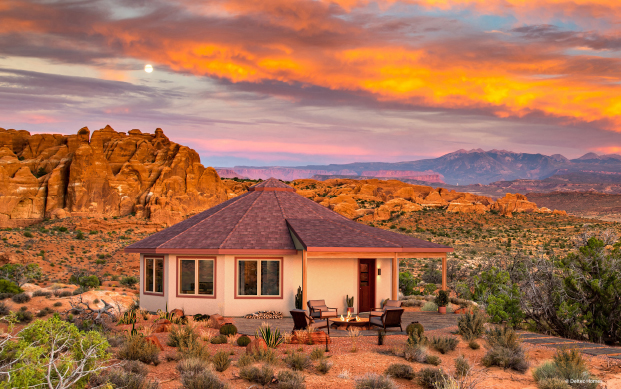SMART WAYS TO GO GREEN
Creating Your Sustainable Home

As we celebrate Earth Day this month, why not put into practice ways to lower our overall impact on the environment? It’s like a ripple effect: a little from each of us can go a long way. The place where we can start making change is the one we know best—our home.
What is a green home? According to the Environmental Protection Agency, green building is defined as creating structures and using environmentally responsible and resource-efficient processes throughout a building’s life cycle. Green building design has been trending for years, but what exactly is it? Going green intentionally reduces the impact on Earth’s resources and involves mindful building design and practices. The design dramatically reduces the structure’s environmental impact using sustainable and eco-friendly materials and lowers the number of resources used to operate a building.
Today, builders are designing homes that limit energy use and carbon emissions, which has tremendous environmental benefits. With climate change in mind, the home construction industry has realized the importance of eco-friendly and sustainable practices and has made huge advancements to support sustainability.
Everyone can contribute to creating a greener and healthier planet. Plenty of doable and affordable options for reducing one’s carbon footprint. Here are innovative ways to make your residence eco-friendlier while saving money.
Create A Home Energy Audit This will help you understand where your energy costs and emissions are coming from. An audit generally costs as little as $100. Home energy auditors check the home thoroughly and inspect air leakage, insulation levels and review electric bills.
Install A Smart Thermostat More than half of our energy usage is heating and cooling a home. Installing a smart thermostat is a brilliant idea, as it gives you more control so you can use the system only as needed. It automatically adjusts to your schedule, the weather, and occupancy, is personalized to your comfort preferences, and can result in direct savings with lower monthly energy bills. Smart thermostats also provide essential data on your weekly and monthly energy usage, so it is easy to identify how much you spend on heating and cooling and adjust accordingly.

Switch To LED Lightbulbs They use up to 90 percent less energy than standard incandescent bulbs and 80 percent less energy than halogen bulbs. Changing your lightbulbs and fixtures to LED not only saves money but reduces your carbon footprint. These energy-efficient bulbs last twenty-five thousand hours compared to twelve hundred for incandescent bulbs.
Upgrade To New Appliances Energy-efficient appliances such as refrigerators, washers, dishwashers, and dryers now consume less electricity than standard models. In 1992, the federal government introduced the Energy Star program, and since then has reduced energy costs by $500 billion and greenhouse gases by four billion metric tons.
Design Your Interior Use eco-friendly furniture, including salvaged wood, recycled textiles, and reused materials. Natural materials like bamboo, rattan, and seagrasses have grown in popularity and are still trending. A few eco-friendly furniture materials that a furniture company uses include reclaimed or sustainably harvested wood, recycled steel, or recycled aluminum for metal furniture. Source furniture from local artisans or purchase from eco-friendly brands.

A NEW HOME FROM SCRATCH
If building a new home is part of your plans, a green home design will help lower your energy bills and reduce your carbon footprint. Sustainability is the new standard. Most importantly, embracing green building practices is both environmentally responsible and economically beneficial.
So, where do you start? The first and most crucial step is site selection and orientation. Choose a lot that maximizes natural light and minimizes energy consumption. Choose a south-facing orientation to take advantage of passive solar heating. Install double-glazed or low-E windows to retain heat in the colder months and keep more relaxed in the hotter season. In terms of materials, select responsibly sourced timber for framing and other wood components and incorporate recycled materials. Geothermal energy is utilized for efficient heating and cooling.
Remember to tap into the sun. According to NASA, every day the sun provides the Earth with 10,000 times the total energy consumed by humans. A passive solar house has been designed to take advantage of that. In simple terms, the home collects heat as the sun shines through south-facing windows and retains it in materials that store heat, known as thermal mass. Passive solar homes also provide daylight all year and comfort during the cooling season with nighttime ventilation.

We recently met with the experts at Deltec Homes, who are familiar with environmental responsibility. It does not mean just lessening our impact but instead finding ways to have a therapeutic, positive effect on our planet through the homes they build. Sustainable construction has earned them a well-deserved reputation as one of the top home builders in the world. They help address the root causes of climate change by dramatically reducing the energy and carbon needed to build and operate the home.
Today, round homes are naturally more energy efficient than traditional homes because they have a more airtight design, making them more efficient to heat and cool. Each home in their new 360 Signature Collection is built Net Zero Ready in most U.S. climate zones—one of the most stringent green building standards in the country. The net impact is that these homes are two times as energy efficient as a typical home.
For more information on Deltec Homes, visit deltechomes.com










